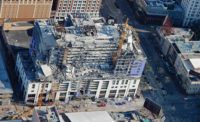McCarran International Airport's new $99-million air traffic control is readying for lift-off. Archer Western Contractors, a unit of Chicago-based The Walsh Group, has been constructing the 352-ft-tall structure for the Federal Aviation Administration since June 2011.

Designed by WHPacific out of its Albuquerque, N.M. office, the project includes a four-story, 52,800-sq-ft base building for radar approach control, air traffic control training simulators, administrative offices and other navigational equipment. The 22-level concrete tower is topped by a two-level 850-sq-ft cab—or controller work area—with 14-ft-tall angled windows for enhanced visibility. By comparison, the existing tower cab is 62% smaller. The new tower will be nearly twice as tall as the current 28-year-old structure.
McCarran's air traffic has increased dramatically since the existing tower was built, creating a need for a taller perch to provide controllers with better airfield views. Years of airport construction has created several blind spots, requiring aircraft to be tracked by radar.
McCarran saw more than 38.3 million arrivals and departures between January and November 2011, up 4.4% for the same period in 2010; the FAA anticipates a 27.8% growth in McCarran arrivals and departures by 2020.
The cast-in-place tower uses Doka's new Super Climber and SKE 50 Plus self-climbing systems, along with 12,000 sq ft of large area formwork. Pour heights on the outside wall reach as high as 19 ft. SKE 50 Plus has automatic brakes and a spring loaded suspension wedge, eliminating manual climbing shoe placements for speedy erection time and greater worker safety. The SKE 50 Plus system will be removed at level 14 because of the cab's slab projection, but the interior core will remain intact.
The new tower is situated between the $2.4 billion, 1.87-million-sq-ft Terminal 3, scheduled to open in September, and the recently-completed $121.7 million, 6,000-space parking garage.
Although the structure is expected to finish construction in the summer of 2013, the FAA won't begin using the new facility until early 2015, following the installation of complex electronics and computer equipment. The old tower will then be demolished.

